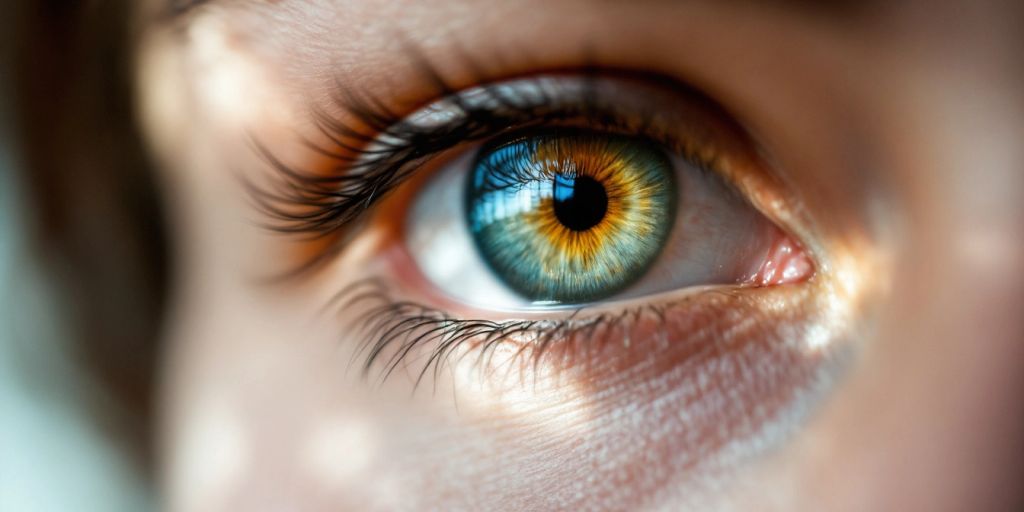Green hazel eyes are a fascinating eye color that is both unique and rare. This special eye color combines various shades and draws attention. In this article, we will explore the peculiarities and characteristics of green hazel eyes, including their genetic foundations, their diversity, and how they differ from other eye colors.
Key Insights
- Green hazel eyes are a mix of brown and green shades.
- Only about 5% of people worldwide have hazel eyes, making them relatively rare.
- The eye color is determined by genes, particularly the OCA2 and HERC2 genes.
- Hazel eyes can change color depending on lighting conditions, making them particularly fascinating.
- Prominent personalities with hazel eyes contribute to the appeal of this eye color.
The Uniqueness of Rare Green Hazel Eyes
What Makes Hazel Eyes Special?
Hazel eyes are a fascinating mix of different colors that can vary depending on lighting conditions. This eye color is not only beautiful but also unique, as it is often perceived as mysterious.
- Color Variations: They can exhibit green, brown, or even golden tones.
- Rarity: Only about 5% of the world’s population has this rare eye color.
- Changes: The eye color can change depending on mood and light.
The Rarity of Green Eyes
Green eyes are even rarer than hazel eyes. They make up only about 2% of the world’s population. This rarity makes them particularly desirable and fascinating.
| Eye Color | Percentage Frequency |
|---|---|
| Brown Eyes | 79% |
| Blue Eyes | 8-10% |
| Hazel Eyes | 5% |
| Green Eyes | 2% |
Color Variations and Mixes
The color variations in hazel eyes are remarkable. They can display a range of tones from green to brown to gold. These mixes make each person with hazel eyes unique.
The uniqueness of hazel eyes is reflected in the diversity of colors and the way they reflect light.
In summary, the combination of rarity and color diversity makes hazel eyes a fascinating topic that interests many people.
Genetic Foundations of Green Hazel Eyes

The Role of OCA2 and HERC2
The genetic basis for green hazel eyes is complex and involves several genes. The two main genes are OCA2 and HERC2. OCA2 is responsible for the production of melanin, while HERC2 regulates the activity of OCA2. These genes influence how much melanin is produced in the iris, which is crucial for eye color.
Inheritance Patterns of Eye Colors
The inheritance of eye colors follows a dominant pattern. This means that if one parent has hazel eyes, there is a high likelihood that the children will inherit this eye color as well. Here are some key points about inheritance:
- A parent with hazel eyes can pass the color to their children.
- Even with two brown-eyed parents, it is still possible for the children to have hazel eyes if both carry the corresponding gene.
- Children of two blue-eyed parents have a very low chance of inheriting hazel eyes.
The Influence of Melanin on Eye Color
Melanin is the main factor that determines eye color. The amount and distribution of melanin in the iris influence whether the eyes appear green, brown, or a mix of both. Here are some aspects that illustrate the influence of melanin:
- Higher melanin levels lead to darker eye colors.
- Lower melanin levels can result in lighter eye colors such as green or blue.
- The structure of the iris also plays a role in light scattering and the perception of eye color.
The genetic basis for eye colors is a fascinating interplay of genes and melanin that explains the diversity of human eye color.
The Diversity of Hazel Eyes

Brown Dominance in Hazel Eyes
Hazel eyes are a fascinating mix of different colors. They often have a brown dominance that distinguishes them from other eye colors. These eyes can appear in various shades, from golden brown to dark brown. The brown tones are usually the result of higher melanin production.
Green Dominance in Hazel Eyes
In contrast, there are also hazel eyes with a green dominance. These eyes often appear more vibrant and can vary depending on lighting conditions. The green color can be combined with golden or brown flecks, giving them a unique appearance.
Gray and Blue Inclusions
Some hazel eyes also show gray or blue inclusions. These additional colors can make the eyes even more interesting and give them a special depth. The combination of different shades makes hazel eyes one of the rarest and most beautiful eye colors.
The diversity of hazel eyes shows how unique and individual each person is. Their colors can change depending on light and surroundings, making them particularly fascinating.
| Type of Hazel Eyes | Description |
|---|---|
| Brown Dominance | Predominantly brown tones with golden or green flecks |
| Green Dominance | Vibrant green tones with brown or golden accents |
| Gray Inclusions | Gray or blue flecks that make the eyes more interesting |
The diversity of hazel eyes is not only an aesthetic feature but also a fascinating topic in genetics and eye color. Their uniqueness makes them an interesting conversation topic and a symbol of the beauty of human diversity.
Differences Between Green and Hazel Eyes
Pigment Distribution in the Iris
The distribution of pigments in the iris is the main difference between green and hazel eyes. While green eyes have an even distribution of pigments, hazel eyes have an irregular distribution that shows both green and brown or golden areas.
Light Scattering and Perception
Green eyes scatter light in such a way that they appear clearly green to the observer. In contrast, hazel eyes can change color depending on lighting conditions and surroundings. These color changes make them particularly fascinating.
Comparison with Brown Eyes
Brown eyes have a higher melanin concentration than hazel eyes. This means they appear darker and do not show green or golden flecks. In comparison, hazel eyes are a mix of different colors, making them unique.
| Eye Color | Melanin Content | Color Variations |
|---|---|---|
| Green Eyes | Low | Solid green |
| Hazel Eyes | Medium | Mix of green, brown, gold |
| Brown Eyes | High | Solid brown |
The differences in pigment distribution and light scattering are crucial for the appearance and perception of eye colors.
In summary, the differences between green and hazel eyes lie in both pigment distribution and the way light is reflected. These features make each eye color unique and fascinating.
Prominent Personalities with Hazel Eyes

Celebrities with Fascinating Eyes
Many well-known personalities have hazel eyes, which are often perceived as particularly attractive. Here are some of them:
- Lady Gaga
- Angelina Jolie
- Ryan Reynolds
- Rihanna
- Channing Tatum
- Jude Law
- Zendaya
The Influence of Eye Color on Attractiveness
Eye color can have a significant impact on the perception of beauty. Studies show that people with hazel eyes are often considered more interesting and attractive. This eye color is frequently associated with a certain mystique and depth.
Hazel Eyes in Pop Culture
Hazel eyes are not only popular among celebrities but also in movies and series. Many characters are portrayed with this unique eye color, enhancing their appeal.
Hazel eyes are a fascinating feature that plays a special role in both nature and culture.
Health Aspects of Hazel Eyes
Risks for Eye Problems
People with hazel eyes have a higher risk for certain eye problems. This is because they often have less melanin, making them more susceptible to conditions such as eye melanoma. Here are some important points to consider:
- Eye Melanoma: A rare form of cancer that affects the uvea.
- Macular Degeneration: A condition that can impair central vision.
- Regular Eye Exams: It is important to see an eye doctor regularly to detect potential problems early.
Protective Measures for the Eyes
To promote eye health, the following measures should be taken:
- Wear Sunglasses: UV protection is crucial to shield the eyes from harmful rays.
- Healthy Diet: A balanced diet rich in fruits and vegetables can support eye health.
- Regular Breaks: When working on screens, regular breaks should be taken to relieve the eyes.
Regular Eye Exams
It is advisable to have an eye exam at least once a year. The eye doctor can:
- Detect potential problems.
- Provide recommendations for eye care.
- Suggest treatments if necessary.
Eye health is important for maintaining quality of life. Take care of your eyes and consult a professional if you have concerns.
The Effect of Light on Hazel Eyes
Changes Due to Sunlight
Light has a significant impact on the perception of hazel eyes. The eye color can change depending on lighting conditions. In direct sunlight, they often appear brighter and more vibrant, while in dim light, they can look darker. These changes are due to the different pigment levels in the iris.
Artificial Lighting and Eye Color
Artificial light sources, such as neon lights or incandescent bulbs, can also influence the perception of hazel eyes. For example:
- Neon light can enhance the green tones.
- Warm white light makes the brown elements appear more dominant.
- Cool light can make the eyes look bluer.
The Illusion of Color Changes
The combination of light and the unique pigmentation of hazel eyes often leads to the illusion that the eye color is changing. These effects can be amplified by various factors:
- Clothing: Certain colors can highlight or change the eye color.
- Emotions: Moods can affect pupil size, altering the perception of eye color.
- Environment: The background and lighting conditions can influence eye color.
The fascinating effect of light on hazel eyes makes them a unique feature that is perceived differently in various situations.
In summary, light plays a crucial role in the perception of hazel eyes and makes them appear in a new light.
Cosmetic Tips for Hazel Eyes
Makeup Tips to Highlight
To enhance the beauty of hazel eyes, the following makeup tips can help:
- Use eyeshadow in complementary colors like purple or green to emphasize the green tones in your eyes.
- Dark eyeliner can make the eyes appear larger and draw focus to the iris.
- Mascara adds volume and length, making the eyes look more vibrant.
Clothing that Highlights the Eyes
Choosing the right clothing can also make a big difference:
- Wear earth tones like brown and beige that emphasize the brown elements in hazel eyes.
- Green tones can highlight the green nuances of your eyes.
- Avoid bright colors that may distract from the natural beauty of your eyes.
Using Colored Contact Lenses
If you want to achieve a dramatic effect, colored contact lenses can be an option. They are available in various shades and can help change or intensify the eye color. Be sure to use only safe and approved products.
Tip: Experiment with different looks to find out what suits you best!
Cultural and Geographical Distribution of Hazel Eyes
Frequency in Different Regions
Hazel eyes are a fascinating eye color that is distributed differently across various cultures and regions. In some countries, they are more common than in others. Here are some interesting facts:
- In the USA, about 18% of the population has hazel eyes.
- This eye color is particularly common among people of Brazilian, Spanish, North African, and Middle Eastern descent.
- In Europe, hazel eyes are also prevalent, especially in countries with a mix of different eye colors.
Cultural Meanings of Eye Colors
Eye color has special significance in many cultures. Hazel eyes are often seen as mysterious and attractive. Here are some cultural perspectives:
- Mystery: People with hazel eyes are considered particularly interesting because their eye color can vary depending on lighting conditions.
- Beauty: In many cultures, hazel eyes are regarded as attractive, leading to a high demand for colored contact lenses.
- Symbolism: In some cultures, hazel eyes symbolize diversity and adaptability, similar to the colors of a chameleon.
Historical Perspectives on Eye Colors
The perception of eye colors has changed throughout history. In the past, certain eye colors were associated with specific traits. Hazel eyes, representing a mix of different colors, show how diverse and dynamic human appearance is.
„The frequency of hazel eyes is a fascinating topic that connects genetic factors and cultural perceptions.“
The Science Behind Eye Color
Research on Genes and Pigments
Eye color is primarily determined by melanin produced in the iris. The more melanin present, the darker the eyes. There are two main types of melanin: eumelanin, which is responsible for dark eyes, and pheomelanin, which produces lighter colors like green or amber.
The key genes that influence eye color are:
- OCA2: Plays a central role in determining eye color.
- HERC2: Regulates the OCA2 gene.
- Other genes like ASIP, TYR, and TYRP1 also contribute to the diversity of eye colors.
Future Studies on Eye Color
Research on eye color is constantly evolving. Future studies may focus on the following aspects:
- Genetic Variations: How different genes interact to influence eye color.
- Environmental Factors: The influence of light and surroundings on the perception of eye color.
- Health Implications: Possible connections between eye color and certain health risks.
Importance of Eye Color in Science
Eye color is not only an aesthetic feature but also has scientific significance. Studies show that eye color can be associated with various health risks. For example, people with lighter eyes may have a higher risk for certain eye diseases.
Eye color is a fascinating example of the complexity of human genetics and its impact on our health and perception.
In summary, the science behind eye color is an exciting field that encompasses both genetic and environmental factors. The rarity of green eyes and the associated genetic foundations make them an interesting topic for future research.
Conclusion
In conclusion, hazel eyes are a fascinating mix of different colors that make them unique. Although they are not the rarest eyes, they are still a rare sight, as only about 5% of the world’s population has this eye color. Their ability to vary depending on lighting conditions gives them a mysterious aura. People with hazel eyes are often perceived as particularly attractive, making them a popular topic in fashion and cosmetics. Ultimately, hazel eyes are not just a genetic trait but also an expression of individuality and beauty.
Frequently Asked Questions
What are hazel eyes?
Hazel eyes are a mix of brown and green tones. They can look different depending on the light.
How rare are hazel eyes?
Hazel eyes are rare, with only about 5% of people worldwide having this eye color.
What causes hazel eyes?
The eye color is determined by genes that influence the amount of melanin in the iris.
Are there different types of hazel eyes?
Yes, hazel eyes can be brown or green dominant and contain various shades.
How do hazel eyes differ from green eyes?
Hazel eyes have an uneven pigment distribution, while green eyes are more evenly colored.
Are people with hazel eyes more prone to eye problems?
People with light eyes, including hazel eyes, have a higher risk for certain eye diseases.
How can I highlight hazel eyes?
Wear colors that highlight your eyes and use eye makeup to emphasize the hue.
Are there famous personalities with hazel eyes?
Yes, many celebrities like Angelina Jolie and Ryan Reynolds have hazel eyes.







